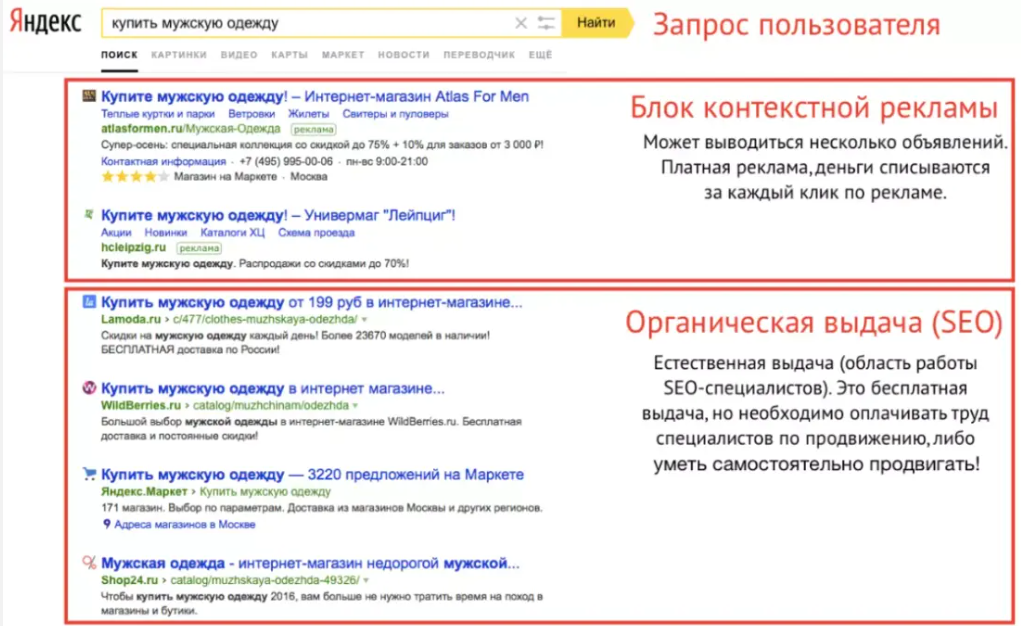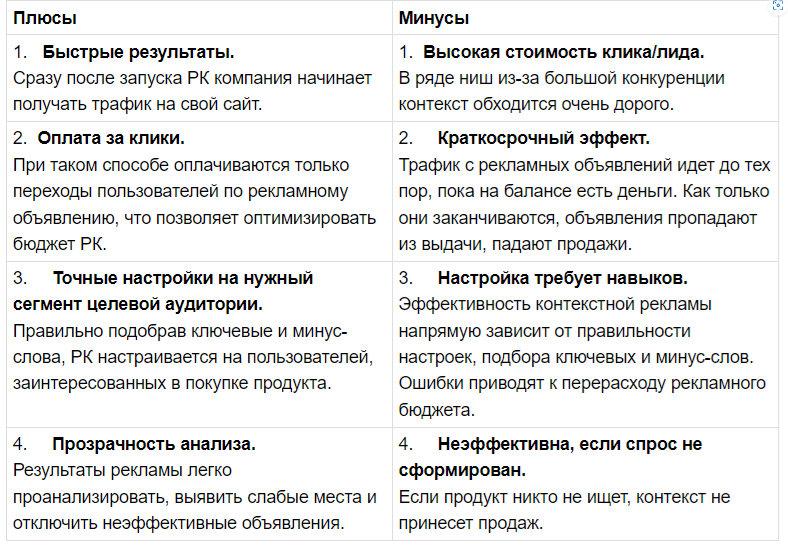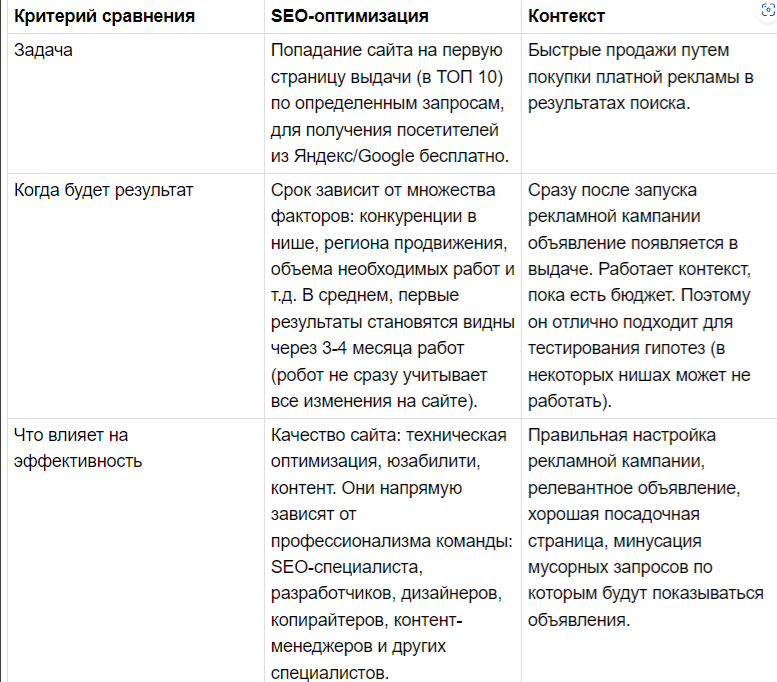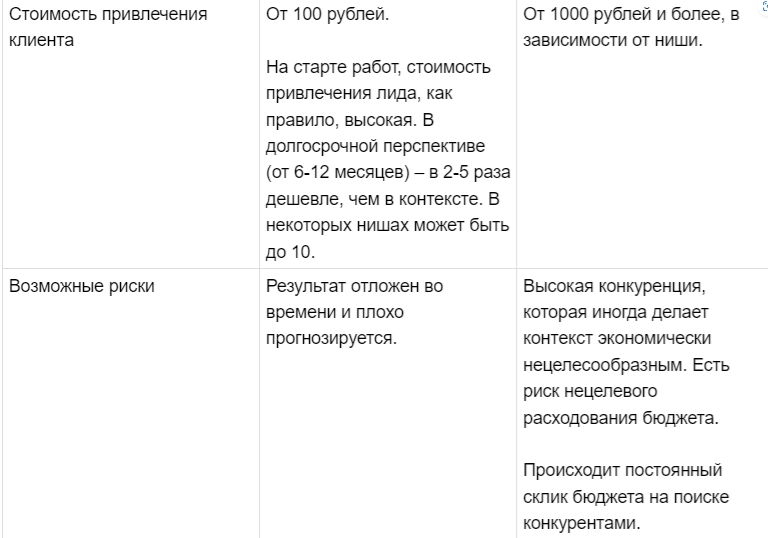Среди всех имеющихся вариантов для продвижения бизнеса в онлайне в Ташкенте, SEO и контекстная реклама являются наиболее распространенными. Однако часто заказчики не видят разницы между ними, потому что результат в их глазах выглядит одинаково: ссылка на их веб-ресурс появляется в результатах поиска Google или Яндекса. Тем не менее, эти два метода продвижения имеют свои отличия, которые влияют на выбор подходящего варианта для продвижения бизнеса в столице Узбекистана — Ташкенте.
Key Features of SEO and Contextual Advertising
Search results include paid ads from advertisers (commercial block) and organic results (organic block).
Коммерческий блок состоит из платных объявлений, которые помечаются как «Реклама».
The organic block consists of websites that the search engine considers to be most relevant to the user's query.
Contextual advertising and SEO ensure that you get into both blocks. Let's look at them in more detail.
Contextual advertising (context)
Контекстная реклама — это рекламные объявления, которые пользователь видит в результатах поиска или на сайтах-партнерах при вводе поискового запроса. Цель контекстной рекламы — привлечь посетителя на сайт и побудить его совершить покупку.
PS: Contextual advertising works well for quick sales. It is ideal for testing hypotheses and selling seasonal products. This is the main advantage of this tool.

The process of setting up an advertising campaign comes down to selecting keywords and creating advertisements. If a user enters one of the selected queries, an advertisement is shown to him. Depending on the campaign settings, advertisements can be displayed in search results (context) or on partner sites (YAN). In this case, the user's search history is taken into account when displaying advertisements on partner resources.
Payment for contextual advertising can be made per click, per 1000 impressions or per conversion, depending on the chosen strategy.
Advertising campaigns can be paused, adjusted, relaunched, ineffective ads can be excluded and new ones can be added. Optimization allows you to reduce unnecessary expenses.

SEO website optimization
SEO (Search Engine Optimization) — это комплекс мер, направленных на оптимизацию сайта с учетом требований поисковых систем. Он включает в себя работу над внешними и внутренними факторами ранжирования (упорядочивания) сайтов в результатах поиска.
External optimization includes placing links on a web resource. Links from authoritative sites are one of the signs of trust for search engines. Internal optimization is related to work directly on the site itself: design, loading speed, interface, ease of use, content (texts) and creation of the necessary pages for promotion, etc.
PS: It takes time for a website to get to the top of search results, so SEO is not a quick way to sell. However, it allows you to work with cold traffic, sell products with a long decision-making cycle, and significantly reduce the costs of contextual advertising in the future.
Например, человек вводит запрос «купить квадрокоптер Mavic 3». Он уже точно знает, что хочет купить. В результатах поиска он видит рекламный блок, а под ним — органические результаты.
After reviewing the descriptions of the sites in the search results, he goes to one of them and, if he likes the offer, he makes an order.
The user basically doesn't care whether he follows an advertising or organic link to the seller's website; the position of the link in the search results and, possibly, the price of the product often play a decisive role. Therefore, contextual advertising, although expensive, shows good results when working with hot demand.
Другая ситуация — человек хочет купить дрон в качестве подарка для ребенка, но не знает, какую модель выбрать. В этом случае он задает запрос иначе: «какой квадрокоптер купить для подростка».
He also sees search results with sites that offer answers to his question. Most likely, these will be articles on blogs of online stores that offer their products. The person follows the link, studies one or more articles, searches for answers to his questions. If he finds useful information, he goes to the online store catalog, views the products and places an order if he finds what he was looking for.
There are differences between SEO and contextual advertising in Tashkent
The task of SEO promotion and contextual advertising in Tashkent is to attract new customers to the site and convert them into targeted actions, such as leaving a request, ordering a service or purchasing. However, the methodology of work in these two approaches differs.
Contextual advertising in Tashkent is aimed at attracting users' attention through advertising and stimulating their transition to the advertiser's website. Therefore, specialists work with campaign settings and ads, but do not change the landing page.
SEO is aimed at changing and improving the site's position in Yandex and Google search results. It includes work directly on the site, improving conversion and, partially, working with external factors.
Here are some examples of differences between SEO and contextual advertising specific to Tashkent:
Local keywords:
SEO: Для продвижения бизнеса в Ташкенте, важно использовать локальные ключевые слова, такие как «рестораны в Ташкенте» или «гостиницы в Ташкенте». Эти запросы помогут привлечь местных пользователей.
Contextual advertising: In contextual advertising, you can use location-specific keywords so that your ad is shown exclusively to local residents of Tashkent.
Seasonal promotions:
SEO: Optimizing content for seasonal events like Navruz New Year in Tashkent can be an important part of your SEO strategy to attract visitors during the holidays.
Contextual advertising: With contextual advertising, you can quickly respond to seasonal promotions and change advertisements and keywords in accordance with current events in Tashkent.
Competitor Analysis:
SEO: Researching your competitors in Tashkent will help you identify their SEO strategies and find unique ways to compete in the local market.
Contextual advertising: In contextual advertising, you can analyze competitors' bids and adapt your bids and ads to compete in Tashkent.
Local reviews and ratings:
SEO: Ratings and reviews on local platforms like Google My Business can impact your site's ranking in organic search results.
Contextual advertising: You can use positive reviews and ratings of your services in contextual advertising to attract more attention of users.
These examples highlight the unique features of advertising and SEO in Tashkent, which can help you better tailor your promotion strategy to local conditions and audience expectations.



Which Method to Choose – SEO or Contextual Advertising: Which Approach is Better in Each Case
No promotion method has absolute advantages, each of them is well suited to solve its own problems. Contextual advertising contributes to instant sales, while SEO optimization attracts targeted traffic from search engines for free, but with a delayed effect.
The choice of method depends on the type of business, seasonality and user demand. Let's consider this in more detail.
Only contextual advertising on search
Contextual advertising on search is ideal for simple niches with clear products, fast transaction cycles, when a service or product is needed immediately, as well as for seasonal sales, for example, Christmas trees for the New Year, flowers for March 8, gifts for September 1, ordering a taxi, calling a tow truck, etc.
This method is also suitable:
For new sites that are not yet optimized for search engines but require instant sales.
For example, if the New Year or March 8th is coming in a month, and the demand for goods increases sharply, there is no time to wait until the necessary pages for promotion in Yandex/Google are created and search robots index them.
For sites with a small number of pages or one-page landing pages that are not planned to be optimized for search engines.
In these cases, contextual advertising will help sell a large volume of goods in a short period of time. You found a contractor, allocated a budget for advertising, launched an advertising campaign, and in 2-3 days you started receiving the first applications.
PS: For maximum effectiveness of contextual advertising, it is necessary to know the target audience, periodically exclude unnecessary requests (for example, photo, download, etc.) so as not to waste the advertising budget, customize ads for different audience groups, etc.
SEO only
SEO promotion is suitable for all types of businesses: wholesalers, manufacturers, factories, service sites, media, etc. In other words, SEO is suitable for almost everyone who has a website and formed user demand.
Why? When a person has a question, what does he do first? That's right, he goes and enters his request in Yandex or Google. There he finds the answers and then makes a decision about ordering services.
Of course, there are situations when it is better to abandon paid sources of attracting visitors in favor of SEO promotion due to high advertising costs, for example, if the cost of an application is 65-130 $ and higher.
If contextual advertising is too expensive, it is better to invest these funds in website development and get traffic from Yandex/Google search results practically for free. Or find alternative ways to attract customers.
What is more profitable: SEO or contextual advertising?
When choosing between SEO and contextual advertising, you need to decide on your business goals. What is more important to you:
- Get orders in the first week with paid advertising?
- Increase your future sales by 2-5 times with SEO optimization and save up to 50% on paid advertising costs?
For clarity, I will give an example of calculating the cost of a client in a competitive niche in Moscow. For this client, end-to-end analytics are available, which displays all traffic sources, the number of orders and the cost of attracting each channel.
Example of calculation of comparison methods:
Компания тратит 4800 $ в месяц на контекстную рекламу (4300 $ — рекламный бюджет, 500$. — оплата услуг специалиста).
Thus, annual advertising costs amount to 55,000 $ rubles, and the cost of attracting one client (lead) is from 30 to 45 $.
SEO promotion of this company's website requires investments of 1250$, i.e. 15000 $ per year, and the cost of attracting a client is reduced to 10-17$. Thus, the savings are 40,000$ per year.
The figures presented allow us to draw conclusions based on specific data.
PS: It should be noted that SEO promotion is not effective for single-page landing pages and some sites created using constructors such as Tilda, LPgenerator, etc. Exceptions are possible, but in most niches these platforms are not suitable for promotion due to the limitations of their engines.
Is it possible to use SEO and contextual advertising at the same time?
Yes, it is possible and yes. In combination, both promotion tools complement each other and allow you to increase sales by at least 2-5 times.
Это можно подтвердить с помощью сервисов сквозной аналитики, которые показывают, сколько и откуда приходит заявок. Если сквозная аналитика настроена, а сайт хорошо оптимизирован, будет наглядно видно, что каждый из каналов генерирует примерно по 50% заказов в полу информационной нише (многие утверждают, что заказов со статей нет — это не так, иначе озоны и другие интернет-магазины не создавали бы раздел блога на своих сайтах).
Using SEO and contextual advertising simultaneously also:
Helps SEO promotion. There was a correlation in the growth of positions/traffic when SEO and paid advertising were launched in the same period. This fact is confirmed by many colleagues.
Why does this happen? Advertising attracts new visitors who interact with the site: view service pages, prices, read blog articles, perform target actions (leave requests for a call, fill out shopping carts, etc.). That is, they perform actions that turn the visitor into a potential client. Search engines, using formulas, evaluate how relevant the site is to the request, take into account user behavior and collect these metrics. Search engines then use the accumulated metrics to organize sites in their results.
Позволяет сэкономить до 50% рекламного бюджета. После начала SEO-продвижения ваш сайт будет показываться на первой странице по определенным запросам через некоторое время. Поэтому часть запросов в платной рекламе можно будет отключить или снизить ставку (в зависимости от стратегии продвижения). Поскольку самые дорогие работы по SEO обычно проводятся в первые месяцы, а потом стоимость продвижения может падать до минимума (стоимость лида в некоторых нишах может быть всего 100 рублей), в рамках общего бюджета это может быть существенной суммой. Если используется только контекстная реклама, у вас нет такой возможности для «рокировки».
Helps to increase the number of requests from the site with the same number of visitors. SEO website promotion includes work to increase the conversion of the site (target actions).
To put it simply, SEO optimizers will give recommendations on how to improve a website to increase the number of applications, even with the same number of visitors. Implementing these recommendations will allow you to quickly increase the number of sales several times.
SEO allows you to get visitors from Yandex and Google at the same time. Search engine optimization for the requirements of search robots allows the site to reach the first page for important queries simultaneously in both search engines. In total, this significantly increases the number of transitions and allows you to save your budget on paid advertising.
PS: Combining methods is also useful from a business perspective. Contextual advertising provides quick sales, but requires a large advertising budget. SEO provides cheap leads in the long term. Together, these methods compensate for each other's shortcomings.
A combination of methods will also give good results if the company has products and situational demand, and a long transaction cycle.
Например, если у человека заболел зуб, он не будет читать статьи «Как вылечить зуб самому» или «Почему болит зуб». Он запишется в клинику, которая будет ближе или предложение которой его устроит. При этом многие процедуры (имплантация, ортодонтия, ортопедия и т.д.) имеют длинный цикл сделки. Для продвижения таких услуг отлично подойдет SEO, так как этот метод позволяет работать с отложенным спросом и холодным трафиком через услуги и статьи.
Conclusion
SEO or contextual advertising: what you need to remember
SEO-продвижение и контекстная реклама — два самых популярных способа увеличения продаж, которые могут использоваться вместе или по отдельности.
PS: You can read about other common customer acquisition channels in the article: Website promotion: Which promotion method is better to choose?
Depending on your goals, these two methods can help you increase your sales by 2-5 times and save up to 50% of your paid advertising budget if you use them together.








